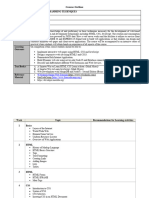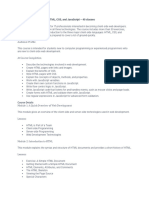0% found this document useful (0 votes)
91 views5 pagesWeb Development Beginner Notes Lessons 1 To 5
The document provides an introduction to web development, covering key concepts such as frontend and backend development, HTML, CSS, and JavaScript basics. It outlines essential tools and techniques for building web pages, including the structure of HTML, styling with CSS, and adding interactivity with JavaScript. The final lesson guides users through creating their first web page by combining these technologies.
Uploaded by
justintrump702Copyright
© © All Rights Reserved
We take content rights seriously. If you suspect this is your content, claim it here.
Available Formats
Download as PDF, TXT or read online on Scribd
0% found this document useful (0 votes)
91 views5 pagesWeb Development Beginner Notes Lessons 1 To 5
The document provides an introduction to web development, covering key concepts such as frontend and backend development, HTML, CSS, and JavaScript basics. It outlines essential tools and techniques for building web pages, including the structure of HTML, styling with CSS, and adding interactivity with JavaScript. The final lesson guides users through creating their first web page by combining these technologies.
Uploaded by
justintrump702Copyright
© © All Rights Reserved
We take content rights seriously. If you suspect this is your content, claim it here.
Available Formats
Download as PDF, TXT or read online on Scribd
/ 5


































































